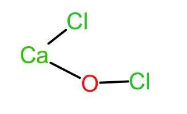
In bleaching powder $(CaO{Cl}_{2})$, oxidation number of the two chlorine atom are:
(A) 0, +1
(B) 0, -1
(C) -1, +1
(D) -1, -2
Answer
147k+ views
Hint: In bleaching powder, $(CaO{Cl}_{2})$ the two chlorine atoms are attached to two different atoms and due to this they have different oxidation states. The oxidation number of an atom is defined as the charge that atom would have possessed if the compound was composed of ions.
Complete answer step by step: The oxidation number or oxidation state is the total no. of electrons that an atom either loses or gains in order to form chemical bonds with another atom. If the oxidation number is positive then that means the atom loses electrons and if it is negative it means that it gains the electrons.
Let us now look at bleaching powder. The chemical name of bleaching powder is calcium hypochlorite or calcium oxychloride and thus has a chemical formula as $CaO{Cl}_{2}$. It acts as a bleaching agent in aqueous solutions only. In bleaching powder, $(CaO{Cl}_{2})$, the two chlorine atoms are attached to two different atoms. One of the chlorine atoms is attached to calcium and the other chlorine atom is attached to oxygen. Thus, the chemical formula can also be written as $Ca(OCl)Cl$. The structure of the same is given below:

Let the oxidation state of Cl attached to calcium be x and oxidation state of Cl in $^{-}OCl$ be y.
We know that Ca is bivalent, therefore,
x = -1 and
2x + y = -1
Substituting the value of x, we get,
2(-1) + y = -1
$\implies $ y = +1
Therefore, the oxidation states of the two chlorine atoms in bleaching powder is -1 and +1.
Hence, option (c) is the correct answer.
Note: It is very important to note that oxidation numbers are always found out for individual atoms and not for groups of atoms. Therefore, in the above case, +1 is not the oxidation number of the group $^{-}OCl$ but of chlorine in $^{-}OCl$. The oxygen in $^{-}OCl$ has oxidation no. of -2.
Complete answer step by step: The oxidation number or oxidation state is the total no. of electrons that an atom either loses or gains in order to form chemical bonds with another atom. If the oxidation number is positive then that means the atom loses electrons and if it is negative it means that it gains the electrons.
Let us now look at bleaching powder. The chemical name of bleaching powder is calcium hypochlorite or calcium oxychloride and thus has a chemical formula as $CaO{Cl}_{2}$. It acts as a bleaching agent in aqueous solutions only. In bleaching powder, $(CaO{Cl}_{2})$, the two chlorine atoms are attached to two different atoms. One of the chlorine atoms is attached to calcium and the other chlorine atom is attached to oxygen. Thus, the chemical formula can also be written as $Ca(OCl)Cl$. The structure of the same is given below:

Let the oxidation state of Cl attached to calcium be x and oxidation state of Cl in $^{-}OCl$ be y.
We know that Ca is bivalent, therefore,
x = -1 and
2x + y = -1
Substituting the value of x, we get,
2(-1) + y = -1
$\implies $ y = +1
Therefore, the oxidation states of the two chlorine atoms in bleaching powder is -1 and +1.
Hence, option (c) is the correct answer.
Note: It is very important to note that oxidation numbers are always found out for individual atoms and not for groups of atoms. Therefore, in the above case, +1 is not the oxidation number of the group $^{-}OCl$ but of chlorine in $^{-}OCl$. The oxygen in $^{-}OCl$ has oxidation no. of -2.
Recently Updated Pages
How to find Oxidation Number - Important Concepts for JEE

How Electromagnetic Waves are Formed - Important Concepts for JEE

Electrical Resistance - Important Concepts and Tips for JEE

Average Atomic Mass - Important Concepts and Tips for JEE

Chemical Equation - Important Concepts and Tips for JEE

Concept of CP and CV of Gas - Important Concepts and Tips for JEE

Trending doubts
JEE Main 2025 Session 2: Application Form (Out), Exam Dates (Released), Eligibility, & More

JEE Main Exam Marking Scheme: Detailed Breakdown of Marks and Negative Marking

JEE Main 2025: Derivation of Equation of Trajectory in Physics

Electric Field Due to Uniformly Charged Ring for JEE Main 2025 - Formula and Derivation

JEE Main Participating Colleges 2024 - A Complete List of Top Colleges

Degree of Dissociation and Its Formula With Solved Example for JEE

Other Pages
JEE Advanced Marks vs Ranks 2025: Understanding Category-wise Qualifying Marks and Previous Year Cut-offs

JEE Advanced 2025: Dates, Registration, Syllabus, Eligibility Criteria and More

JEE Advanced Weightage 2025 Chapter-Wise for Physics, Maths and Chemistry

Hydrocarbons Class 11 Notes: CBSE Chemistry Chapter 9

NCERT Solutions for Class 11 Chemistry In Hindi Chapter 1 Some Basic Concepts of Chemistry

Learn About Angle Of Deviation In Prism: JEE Main Physics 2025




